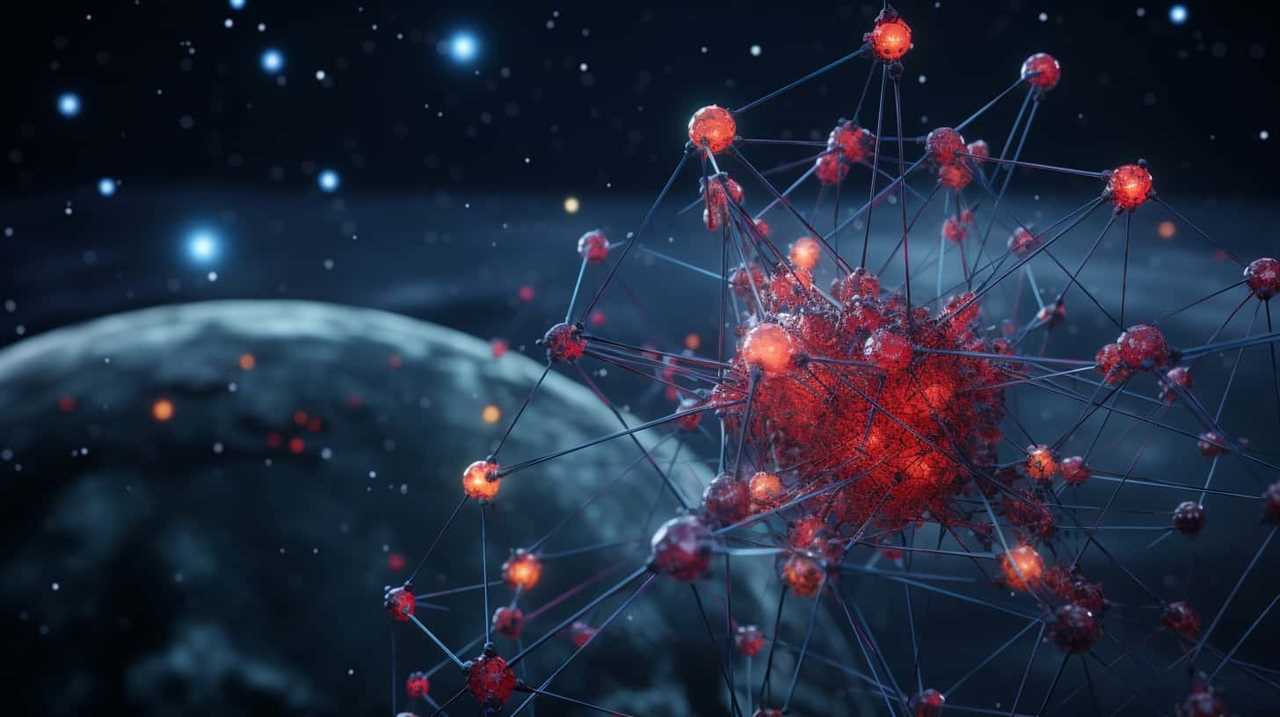We find ourselves at the leading edge of a digital combat zone, where artificial intelligence systems are perpetually threatened by cyber incursions. Our objective is unmistakable: to safeguard and preserve these indispensable systems against the continually changing dangers they encounter.
In this article, we will explore the types of attacks targeting AI systems, identify their vulnerabilities, and discuss the importance of securing these systems. Join us as we delve into the intricate world of AI system defense, where vigilance and innovation are paramount.
Key Takeaways
- Adversarial attacks, AI model poisoning, data poisoning, model inversion attacks, and evasion attacks are common types of cyber attacks on AI systems.
- Inadequate data protection, adversarial attacks, model poisoning, backdoor attacks, and lack of transparency are common vulnerabilities in AI systems.
- Securing AI systems is important due to the devastating consequences of cyber attacks, the integration of AI systems into critical infrastructure, and the need for robust security measures and monitoring.
- Best practices for securing AI systems include conducting risk assessments, having an incident response plan, updating software and hardware, implementing access controls and authentication measures, and continuous training on AI system security.
Types of Cyber Attacks on AI Systems
In our exploration of defending against cyber attacks on AI systems, let’s begin by examining the different types of attacks commonly encountered.
Two prominent types of attacks are adversarial attacks and AI model poisoning. Adversarial attacks involve manipulating input data to deceive AI systems, causing them to make incorrect predictions or decisions. This can be achieved by adding imperceptible perturbations to images or texts, fooling the AI model into misclassifying or misinterpreting the data.

On the other hand, AI model poisoning is an attack where an adversary injects malicious data into the training set, with the intention of compromising the model’s performance or introducing biases. These attacks exploit vulnerabilities in AI systems, which we’ll delve into in the subsequent section about common vulnerabilities in AI systems.
Common Vulnerabilities in AI Systems
To understand the vulnerabilities in AI systems, we must first identify the potential weak points that can be exploited by cyber attackers. AI systems, while powerful and intelligent, aren’t immune to attacks. Here are some common vulnerabilities that can be found in AI systems:
- Inadequate data protection: AI systems rely heavily on data, and if this data isn’t properly protected, it can be accessed or manipulated by attackers.
- Adversarial attacks: These attacks involve manipulating input data in a way that misleads the AI system, causing it to make incorrect decisions.
- Model poisoning: Attackers can inject malicious data into the training process, compromising the integrity and accuracy of the AI model.
- Backdoor attacks: This involves inserting hidden vulnerabilities during the development of the AI system, allowing attackers to gain unauthorized access.
- Lack of transparency: AI systems often lack transparency, making it difficult to identify and address vulnerabilities, and raising ethical implications regarding accountability and fairness.
Understanding these vulnerabilities is crucial in protecting AI systems and ensuring their ethical use.
Importance of AI System Security
Ensuring the security of AI systems is of utmost importance if we want to protect them from cyber attacks. The importance of AI system security can’t be overstated, as the impact of cyber attacks on these systems can be devastating.

AI systems are vulnerable to various types of attacks, including data breaches, malware infections, and manipulation of training data. The consequences of a successful cyber attack on an AI system can be significant, ranging from compromised data integrity to unauthorized access and control.
The potential implications extend beyond individual systems, as AI systems are increasingly being integrated into critical infrastructure and decision-making processes. Therefore, it’s crucial to implement robust security measures to safeguard AI systems from cyber threats.
This includes regular vulnerability assessments, strong authentication mechanisms, encryption of sensitive data, and continuous monitoring for any suspicious activities. By prioritizing AI system security, we can mitigate the risks and ensure the integrity and reliability of these systems in an increasingly connected world.
Best Practices for Securing AI Systems
Implementing robust security measures is essential for safeguarding AI systems against cyber attacks. When it comes to securing AI systems, conducting a thorough risk assessment is crucial. This assessment helps identify potential vulnerabilities and threats specific to the AI system, allowing for the development of targeted security strategies.

Additionally, having a well-defined incident response plan is essential. This plan should outline the steps to be taken in the event of a security breach or cyber attack, ensuring a timely and effective response.
Furthermore, regularly updating and patching AI system software and hardware is necessary to address any known vulnerabilities.
Lastly, implementing strong access controls and authentication measures helps prevent unauthorized access to the AI system.
Role of Machine Learning in AI System Defense
We can leverage machine learning to enhance the defense of AI systems against cyber attacks. Machine learning algorithms play a crucial role in detecting and mitigating security threats in real-time. These algorithms are trained on large datasets to recognize patterns and anomalies, allowing AI systems to continuously learn and adapt to new attack vectors.

By analyzing network traffic, system logs, and user behavior, machine learning algorithms can identify malicious activities such as intrusion attempts, malware infections, and data breaches. This enables AI systems to proactively respond to threats and implement appropriate security measures, such as blocking suspicious IP addresses or isolating compromised components.
Additionally, machine learning algorithms can help in identifying and prioritizing vulnerabilities, enabling organizations to allocate their resources effectively for system hardening. By integrating machine learning algorithms into AI system defense, organizations can significantly enhance their security posture and protect against evolving cyber threats.
In the subsequent section about securing data in AI systems, we’ll explore the importance of data protection mechanisms and encryption techniques to safeguard sensitive information from unauthorized access or tampering.
Securing Data in AI Systems
To fortify the defense of AI systems against cyber attacks, it’s essential to establish robust mechanisms for safeguarding the data within these systems. Data privacy is of utmost importance when it comes to protecting AI systems. Encryption techniques play a crucial role in ensuring the confidentiality and integrity of the data.

Here are five key points to consider:
- Implement strong encryption algorithms to secure data both at rest and in transit.
- Utilize techniques like homomorphic encryption to perform computations on encrypted data without compromising privacy.
- Employ access controls and authentication mechanisms to restrict unauthorized access to sensitive data.
- Regularly monitor and audit data access to identify any potential breaches or anomalies.
- Continuously update encryption techniques and stay informed about emerging threats to maintain the highest level of data security.
Securing data is just one aspect of protecting AI systems. Now let’s delve into the challenges that arise in this process.
Challenges in Protecting AI Systems
When it comes to protecting AI systems, there are several challenges that need to be addressed.
One key challenge is conducting AI vulnerability assessments to identify potential weaknesses and vulnerabilities in the system.

Another challenge is implementing advanced threat detection mechanisms that can detect and respond to emerging cyber threats in real-time.
Lastly, developing robust defense strategies that can effectively mitigate and prevent attacks is crucial for ensuring the security of AI systems.
These challenges require a comprehensive and proactive approach to safeguard AI systems from potential cyber attacks.
AI Vulnerability Assessments
As we delve into the challenges of protecting AI systems, it’s crucial to address the complexities of conducting AI vulnerability assessments. These assessments play a vital role in identifying and mitigating potential risks associated with AI systems.

Here are some key points to consider when conducting AI vulnerability assessments:
- Comprehensive risk assessment: Conducting a thorough assessment of potential vulnerabilities is essential to identify all possible risks to the AI system.
- Identifying attack vectors: Understanding the different ways in which attackers can exploit vulnerabilities is crucial for effective vulnerability management.
- Testing for weaknesses: Assessing the AI system’s resilience against various attack techniques helps uncover potential weaknesses that need to be addressed.
- Monitoring and detection: Implementing robust monitoring and detection mechanisms enables the identification of any suspicious activities or potential breaches.
- Regular updates and patches: Keeping the AI system up-to-date with the latest security patches and updates is essential to address any known vulnerabilities.
Advanced Threat Detection
Now, let’s delve into the challenges we face in protecting AI systems with advanced threat detection, as we frequently encounter sophisticated cyber attacks targeting these systems.
One of the key challenges lies in implementing effective behavioral analytics to detect anomalies in AI systems. Traditional security measures are often insufficient in identifying malicious activities within these complex systems. Behavioral analytics, powered by machine learning algorithms, can help identify abnormal patterns and behaviors that indicate a potential cyber attack. However, developing accurate and robust models that can effectively differentiate between normal and malicious behavior remains a challenge.
Additionally, the dynamic nature of AI systems introduces further complexity, requiring constant monitoring and updating of the behavioral analytics models. Moreover, the vast amount of data generated by AI systems poses a challenge in terms of scalability and real-time analysis.

Overcoming these challenges is crucial in ensuring the security and integrity of AI systems against evolving cyber threats.
Robust Defense Strategies
To effectively defend against cyber attacks targeting AI systems, we must develop robust defense strategies that address the challenges of protecting these complex and dynamic systems. AI systems are vulnerable to a wide range of threats, requiring the implementation of comprehensive defense mechanisms and cybersecurity measures.
Here are five key considerations for developing effective defense strategies:
- Implementing multi-factor authentication: By requiring multiple forms of verification, such as passwords and biometrics, we can enhance the security of AI systems and prevent unauthorized access.
- Conducting regular vulnerability assessments: Regularly evaluating the system for potential weaknesses and vulnerabilities allows us to proactively identify and address security gaps.
- Employing encryption techniques: Encrypting data both at rest and in transit ensures that sensitive information remains secure and protected from unauthorized access.
- Implementing intrusion detection and prevention systems: These systems monitor network traffic and identify and block any suspicious activities or attempted intrusions.
- Establishing incident response and recovery plans: Having a well-defined plan in place enables quick and efficient response to security incidents and minimizes the impact of any potential breaches.
AI-specific Threats and Countermeasures
One major concern when it comes to AI systems is the potential for various threats and attacks, which require us to implement effective countermeasures.

AI system vulnerabilities can arise from both external and internal factors.
External threats include malicious actors attempting to exploit weaknesses in the AI infrastructure, such as unauthorized access or data breaches.
Internal threats, on the other hand, involve vulnerabilities within the AI system itself, such as algorithmic bias or robustness issues.
To protect AI infrastructure, it’s crucial to adopt a multi-layered approach.

This includes implementing strong authentication and access controls, regularly updating and patching software, and conducting comprehensive security audits.
Additionally, continuous monitoring and analysis of AI system behavior can help detect and mitigate potential threats in real-time.
AI System Monitoring and Detection Techniques
When it comes to protecting AI systems against cyber attacks, real-time threat identification and anomaly detection methods play a crucial role.
By continuously monitoring the system’s activities, we can identify any suspicious behavior or deviations from normal patterns. Real-time threat identification techniques allow us to detect and respond to potential attacks promptly, minimizing the impact on the AI system’s integrity and performance.

Anomaly detection methods, on the other hand, help us identify unusual activities that might indicate the presence of a cyber attack.
Together, these monitoring and detection techniques provide essential insights for defending AI systems against potential threats.
Real-Time Threat Identification
At all times, we monitor and detect threats in real-time to ensure the protection of our AI systems against cyber attacks. Real-time threat identification is crucial for preventing potential security breaches and safeguarding AI systems.
To achieve this, we employ advanced monitoring and detection techniques that enable us to promptly identify and respond to emerging threats. Some key aspects of our real-time threat identification approach include:

- Continuous monitoring of network traffic and system logs.
- Utilizing machine learning algorithms to detect anomalies and suspicious activities.
- Implementing intrusion detection and prevention systems.
- Conducting regular vulnerability assessments and penetration testing.
- Collaborating with threat intelligence platforms to stay updated on the latest security threats.
Anomaly Detection Methods
To further enhance our real-time threat identification capabilities, we consistently employ anomaly detection methods to actively monitor and detect any unusual activities in our AI systems.
Anomaly detection techniques play a crucial role in safeguarding our AI systems against potential cyber attacks. These methods involve the use of machine learning algorithms that are trained to identify deviations from normal behavior patterns.
By analyzing large volumes of data and establishing baselines, our anomaly detection system can effectively identify any abnormal activities that may indicate a potential security breach or malicious intent.
This proactive approach allows us to quickly respond to emerging threats and mitigate potential risks to our AI systems.

Our use of advanced machine learning algorithms ensures that our anomaly detection methods are continually refined and optimized to provide accurate and reliable results.
Future Trends in AI System Security
One significant trend in AI system security is the adoption of proactive measures to mitigate potential cyber threats. As the field of AI continues to advance, it’s crucial to consider the ethical implications and regulatory frameworks surrounding the security of these systems.
To address these concerns, several key trends are emerging:
- Enhanced threat intelligence: AI-powered systems are being developed to actively monitor and analyze potential threats, enabling organizations to stay ahead of cyber attacks.
- Robust authentication mechanisms: Implementing multi-factor authentication and biometric recognition systems can strengthen the security of AI systems, preventing unauthorized access.
- Explainability and transparency: Organizations are striving to make AI systems more transparent and explainable, ensuring that their decision-making processes can be understood and audited.
- Privacy-focused designs: Emphasizing privacy protection in AI system development helps mitigate the risk of data breaches and unauthorized access to sensitive information.
- Collaborative defense networks: Establishing partnerships and sharing threat intelligence among organizations fosters a collective defense against evolving cyber threats.
These trends reflect the growing emphasis on proactive security measures and the need for comprehensive strategies to safeguard AI systems in the future.

Frequently Asked Questions
How Can AI Systems Be Protected From Social Engineering Attacks?
To protect AI systems from social engineering attacks, we must focus on detecting manipulation and preventing data breaches. By implementing robust security measures and educating users about potential scams, we can safeguard our AI systems from these threats.
What Are the Potential Risks of Using AI Systems in Critical Infrastructure?
Potential vulnerabilities in AI systems used in critical infrastructure can have a significant impact on national security. We must recognize the risks involved and implement robust defense mechanisms to safeguard against cyber attacks.
Are There Any Specific Regulations or Standards in Place for Securing AI Systems?
There are numerous regulations and standards in place for securing AI systems. These guidelines provide a framework for safeguarding against cyber attacks and ensuring the integrity and resilience of AI technologies.
Can AI Systems Be TrAIned to Detect and Prevent Zero-Day Attacks?
Yes, AI systems can be trained to detect and prevent zero-day attacks. By continuously analyzing patterns and behaviors, AI can identify and mitigate advanced cyber threats, enhancing the defense of AI systems.

How Does the Integration of BlockchAIn Technology Enhance the Security of AI Systems?
Blockchain integration enhances AI system security by providing a decentralized and immutable ledger that ensures the integrity and confidentiality of data. It also enables secure and transparent transactions, preventing unauthorized access and manipulation of AI systems.
Conclusion
In the ever-evolving landscape of cybersecurity, protecting AI systems is of utmost importance. Just as a fortress needs impenetrable walls, AI systems require robust defenses to safeguard against the relentless onslaught of cyber attacks.
By understanding the types of attacks, vulnerabilities, and best practices for securing AI systems, we can fortify their defenses and ensure their integrity.
As we navigate the complexities of AI-specific threats and countermeasures, constant monitoring and detection techniques will be crucial in staying one step ahead of potential breaches.

Together, we can secure the future of AI system security.








